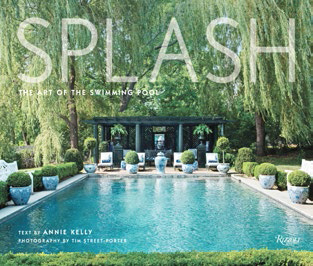Splash! - Page 4
 |
|
|
 |
|
|
Eckbo and Royston, influenced by abstract art, created gardens that were both places to live and places to admire for their compositional beauty.
Writing about the work of Eckbo, the curator and author Robert Stearns, also in the book Swimming Alone, wrote:
"The water of the pool added a material variation to paving stones, concrete, mowed lawns, plant beds, shrubs, and trees. And water offered unique light qualities depending on the color of the pool shell, time of day, and sky conditions."
To this day backyard pools (or side yard or rooftop or even pools that slide beneath interior rooms) continue to function as art objects as well as centers of athletic activity.
In Splash, Kelly and Street-Porter show off beautiful pool designs ranging from modern to traditional to exotic, and from California to Mexico, France, Bali, and beyond. Surprisingly enough, Kelly says, when the prolific writing-photo duo began researching topics for their next book, they discovered little in the way of swimming pool competition.
Palm Springs, not surprisingly, is awash in mid-century modern pools, with tract home after tract home having distinctive designs—or at least distinctive poolside décor.
A small pool, but very pleasing, is the asymmetrical oval-shaped pool pioneering desert architect Albert Frey built for his own compact home on a ridge 220 feet above the desert floor. The pool is in a concrete deck above the carport.
But if the pool emerged as an art form—which is how Kelly and Street-Porter choose to portray it—pools were also a fact of life for ordinary Americans, both at home and on the road.
"The backyard pool holds an incredibly powerful place in the pantheon of American iconography," Ryan Murtha writes. "Like the two-car garage, the backyard in-ground pool has in many ways become a hallmark of the middle class, a symbol of achieving the so-called American Dream."
Public municipal pools, YMCAs, even such fabulous public pools as the Fleishhacker Pool in San Francisco, whose saltwater could handle 10,000 people at a time, attracted many. (The Fleishhacker closed in 1971).
But the backyard pool had an appeal like no other. It was so easy to slip into at any time, so convenient for kids' daytime parties and adult evening soirees.
Author Jennifer Watts suggested that the backyard pool was becoming a defining element of modern American life.
"The recreational oasis as seen in magazines, with its concrete, Polynesian decorations, inflatable rafts, water toys, and plenty of food and drink besides, seemed to offer the very best of suburban living," she wrote.
And when American families hit the road, they found they were never far from a swimming pool, mostly rectangular, a few kidney-shaped pools, some shaped like lazy figure eights, and many with diving boards and slides.
Some scholars of motels in mid-century America have suggested that pools were designed to catch people's eye as they drove by but didn't get much use. But anyone who remembers driving the countryside as a boy or girl during the period would argue otherwise.
What was the first thing we kids wanted to see when Dad pulled into our destination? The depths of Carlsbad Caverns? The fields of Gettysburg? A bunch of presidential heads carved out of a mountain? No! "Where's the pool, Mom? Where's the pool?"
Splash!
Photography: Tim Street-Porter, Sabrina Huang Photography, Leland Lee, John Eng, H. Armstrong Roberts, Ewing Galloway, Mihajlo Maricic, Tom Kelley Archive, George Marks, Bryan Costales, Julius Shulman (© J. Paul Getty Trust. Getty Research Institute, Los Angeles); and courtesy William Bird Archive, Rizzoli New York
- « first
- ‹ previous
- 1
- 2
- 3
- 4




